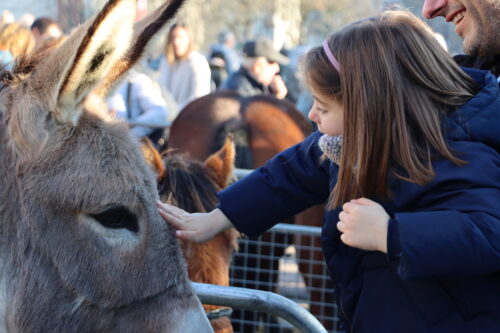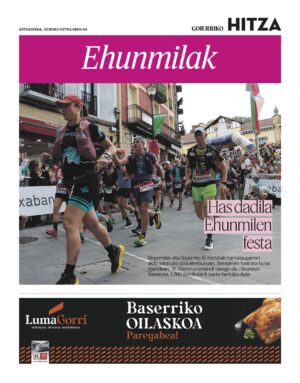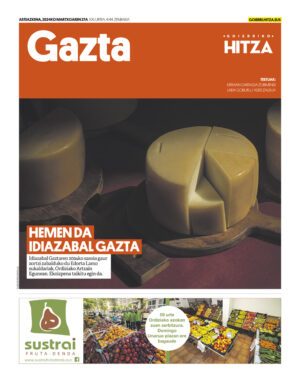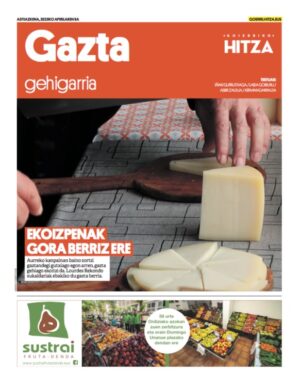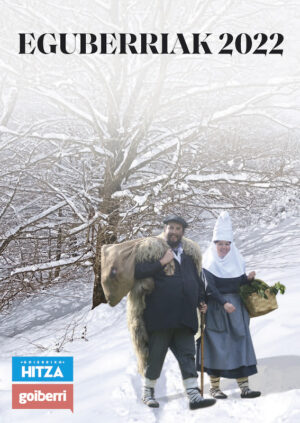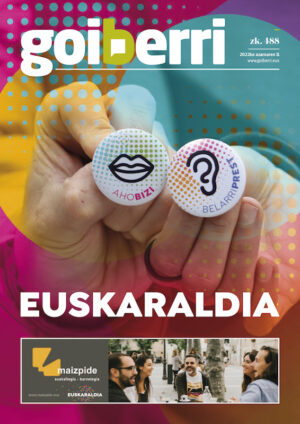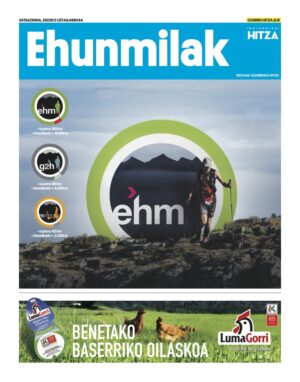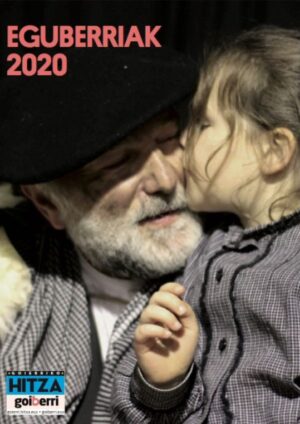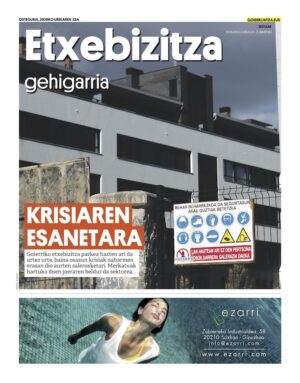GOIERRIKO HEDABIDEAK
GOIERRIKO HITZA egunkari zabala eta independentea izateko sortu zen, euskal komunitateko sentsibilitate guztiak kontuan hartzekotan sortu ere. Ezaugarri horiek bermatu eta pluraltasunaren alde egiteko konpromisoarekin kaleratzen du GOIERRIKO HEDABIDEAK S.L. enpresak.
Gizarteari zerbitzu bat eskaintzen dio GOIERRIKO HITZAk, bai paperean eta bai Interneten: euskal hiztun guztiek osatutako komunitatean, Goierriko eskualdean euskaraz argitaratzen den egunkari orokor bakarra da, eta komunitate horrek osatutako irakurleria dauka erreferentziatzat. Hizkuntzaren bitartez euskaldunen komunitatearen indar kohesionatzaile eta integratzaile gisa ari den kultur baliabide modernoa da, eta tresna sozial bateratzailea.
Jarraibideak
Ikuspegi aniztasuna
GOIERRIKO HITZAn, aniztasunaren alde egingo da. Kolaboratzaile, zutabegile, blogari eta, oro har, GOIERRIKO HITZAn idazten duten guztien iritziak bere hartan errespetatuko dira. Euskal irakurleen artean dagoen iritzien zabala kontuan hartuko da. Informazioa emateko, alde guztien ikuspuntuak bilduko dira, eta albistearen alde guztietako protagonistei ahotsa emateko ahalegina egingo da beti.
Kazetarien jardunbidea
Informazio bat albiste bihurtuko den erabakitzeko, haren egiatasuna ziurtatu eta iturriak fidagarriak direla egiaztatu beharko du kazetariak, ezer baino lehen. Gizartean hedatutako zurrumurruak ez dira albiste iturritzat hartuko GOIERRIKO HITZAn.
Kazetariak zintzotasunez erantzun behar dio lanbideari:
- Informazioa era zilegian biltzen ahalegindu behar du.
- Albistea egiatasunez ematen saiatu.
- Giza eskubideak errespetatu edukietan.
- Hizkuntza ere zuzen eta egoki baliatu.
Informazioa biltzeko bideak
Kazetaritzaren jardunean, informazioa bilatu eta eskuratzea da lehenengo zeregina. Ez da edozelan egin behar: kazetariak zilegizkoak diren bideak erabiliko ditu argazkiak, adierazpenak eta dokumentuak lortzeko. Kazetariak ez du ahaztu behar, irakurleek duten informazio eskubidea gorabehera, pertsonek ez dutela zertan erantzun kazetariak egindako galderei, ezta hark eskatutako frogarik zertan eman ere.
Informazioa bide zilegietatik lortzeko ahaleginari lotuta, sekretu profesionala da kazetariaren betekizun nagusietakoa: iturriari zor dion isilpekotasuna. Kazetariak informazio iturriaren izena inori ez emateko betekizuna du, iturriak hala eskatzen dionean.
Egiatasuna
Herritar guztiei dagokie informazio zuzen eta egiazkoa eskuratzeko eskubidea, eta kazetariaren beste egiteko nagusietako bat da hori bermatzea. Horretarako, jarrera prestua erakutsi behar du: errealitateari objektiboki begiratuko dio, eta talaia horretatik saiatuko da informazioa atontzen, betiere eskura dituen datuak zein dokumentazioa behar bezala egiaztatuta eta gertaerak dagokien testuinguruan kokatuta (espazio-denboretan, aurreko gertakariekin lotuta, nondik norakoak eta zergatiak azalduta…).
Gertaeren gaineko zurrumurru, uste, iritzi-miritzi eta esamesek ez dute lekurik informazioan. Gertaerak beren testuinguruan azaldu behar dira; haiek ulertzeko eta interpretatzeko behar beste datu eman behar dizkio kazetariak irakurleari. Gainera, zerikusia izan duten aldeen edo ondorioak jasan dituztenen bertsioa jasotzea ezinbestekoa da albistearen osotasunari erreparatzeko. Zehatz eta inpartzialki idatzi behar da: gertaeren deskripzio objektibotik aldendu gabe. Eskura duen informazio garrantzitsurik ez du ezkutatu edo isilduko, albistearen protagonistetako baten alde egitearren.
Kazetariak bere esku dauden neurri guztiak hartu arren inoiz albisteren bat akats eta guzti argitaratzen bada, zuzendu egingo da lehenbailehen, argitaratu eta biharamunean ahal dela: akatsa eta datu zuzena, biak argi adieraziz, eta ondo ikusteko tokian eta moduan. Zuzenketaren ardura albistea argitaratu den sailari dagokio.
Giza eskubideak
Edozein herritarrek bezala, banakoen oinarrizko eskubideei errespetua zor die kazetariak. Hasteko, pertsonen ohore, intimitate eta irudi eskubideei kalterik egin gabe jokatu behar du. Norbaiten aurkako gezurrak eta irainak esatea ohorearen aurka jotzea da, eta haren izen ona zikintzen du. Banakoei dagozkien gertaera, datu eta sekretuak zabaltzea intimitatearen aurkako erasotzat jotzen da, baldin eta ezagun eta publikoak ez badira, are protagonistak baimenik eman ez badu. Inoren izenari kalte larria egiten dion irudirik ez du argitaratuko GOIERRIKO HITZAk, ez informazio ataletan, ez publizitatekoetan.
Informazioaren protagonisten ohorea eta duintasuna babesteko, ez da jakinaraziko istripuetan hildakoen edo larri zauritutakoen, eta hondamendien eta indarkeriaren biktima izan diren adingabeen izenik.
Era berean, elkarrizketa bat publikatu aurretik elkarrizketatua larri zauritu, gaixotu edo hiltzen bada, GOIERRIKO HITZAk ez du publikatuko, non eta ez duen haren edo familiaren baimena.
Bere buruaz beste egin duten pertsonen izen osoa ere ez da jakinaraziko: nahikoa izango da inizialak ematea. Pertsona publikoekin bakarrik egin liteke salbuespena.
Errugabetasun presuntzioa oinarrizko eskubidea dute herritar guztiek: kazetariak ez du inor epaituko, ez informazio sailetako albisteetan, ez iritzi saileko artikuluetan; are gutxiago, atxilotuta baina epaitu gabe dauden pertsonak.
Hizkuntza
Hedabideen zereginetako bat da hizkuntzaren erabilera egokia sustatzea, esamoldeak eta ereduak zabaltzeko bideak jartzen dituztelako. GOIERRIKO HITZAk ardura handiz heltzen dio lantegi horri.
Hizkuntzaren, edo are komunikazioaren arloan, gramatika eta pragmatika aldetik guztiz egokiak diren testuak idatzi behar ditu kazetariak. Zuzentasun sintaktikoa du oinarrizko maila: errealitatearen deskripzioan, faltsutasunik eta anbiguotasunik ez sortzeko, gaizki ulertzeko modurik ez emateko, nahasketarik ez eragiteko.
Baina hizkuntzaren zuzentasunaz gain, zeinu hutsetik harago doan errealitate baten esanahia dute hitzek, eta zerbaiten erreferentzia dira; horiek egiazkoak zein faltsuak izan litezke. Kazetariak egiaz betetako esanahiak eman behar ditu, gauzak diren bezala adierazi. Zuzentasun semantikoari ezin dio ihes egin.
Gainera, kazetariak ondo jabetu behar du bere hitzek duten oihartzunaz. Bere mezuek irakurleengan dituzten ondorioen erantzule baita.
Inoiz ez da gaitzespen esapiderik erabiliko protagonistei buruz, ez aurreiritzirik edo arbuiozko konnotaziorik sor lezakeen hitzik.
Informazioa eta iritzia
Objektibotasuna aipatu ohi da informazioaren ezaugarri nagusitzat. Kazetariari ahaleginean eta jarreran eskatzen zaion zintzotasun intelektuala izango da bere produktuaren objektibotasuna neurtzeko adierazlea. Eta hori gertaeren egiazkotasunarekin lotuta dago, batetik, eta inpartzialtasunarekin, bestetik. Horren ezaugarri nagusiak zorroztasuna eta zehaztasuna dira. Eta ondoz ondo: iturrien balioa aztertzea eta egiaztatzea, informazio elementuen arteko barne kohesioa gordetzea, elementu garrantzitsurik ez isiltzea… Horrek esan nahi du gertaeren berri emateko, zintzotasunaz gain, albiste izaera emateko hautatu diren irizpideak berak ere objektiboak direla. Hala, beraz, behar besteko distantzia hartuko du gaiari buruzko informazioa ematean, inongo aldetara lerratu gabe.
Informazio generoetan ez zaio iritzi pertsonalik onartuko kazetariari, eta gertaeretan eta datuetan oinarrituta baino ez du landuko albistea. Informazio eta iritzi generoen artean, interpretaziozkoak daude.
Informazio generoetako albisteak eta iritzizkoak ez dira edonola nahastuta emango orri berean. Iritzi saileko artikuluak eta idatziak berariazko orrialdeetan kokatu ohi dira GOIERRIKO HITZAn.
Edozein herritarrek bezala, kazetariak ere eskubidea du bere iritziak plazaratzeko, baina, sinatzen dituen testuen autore izanik, haietatik sor litezkeen liskar eta auzien erantzule izango da, norbaiten ohore eta intimitatearen aurka eginez gero bere artikuluetan.
Informazio iturriak
Argi eta garbi adieraziko da kazetariak zein iturri erabili duen informazioa lantzeko.
Informazio iturriak behar bezala identifikatu behar dira. Iturria zehatz aipatu ezin bada, ez da erabiliko “iturri fidagarrien arabera” eta antzeko formulaziorik. Izan ere, fidagarria izan ezean, kazetariak ez du aintzat hartuko.
Batzuetan, iturri batek informazioa ematen du bere izena isilean gordetzeko esanda: “off the record” lortutako informazioa dela esaten da. Horretarako benetako arrazoiren bat dagoenean bakarrik onartuko da “off the record” izatea, eta ez iturriaren kapritxo bati, edo maltzurkeriaren bati, men eginda.
“Off the record” eskuratutako informazioa ez da bere hartan argitaratuko, salbu beste alde batetik baieztatua denean.
Iturri anonimoek ez dute lekurik GOIERRIKO HITZAn. “Jendeak dioenez”, “Politika adituen esanetan” eta antzeko formulazioek ez diote sinesgarritasunik ematen albisteari; alderantziz, kazetariaren iritzia estaltzeko bidea dira. Tentazio hori saihestu egin behar da beti. Jendea, auzokideak, adituak eta beste nor diren ere ongi identifikatuko da.
Informazio iturria beste hedabide bat bada, lehenbailehen aipatu behar da.
Argazkiak
Argazkiak informazio elementuak dira.
Argazkiak teknikoki tratatzen dira GOIERRIKO HITZAn hartarako programa informatikoekin, baina ez dira manipulatuko ez irudia bera eta ez testuingurua. GOIERRIKO HITZAk ahalegin berezia egingo du argazkilariek landuriko konposizioak bere hartan gordetzeko, aldatu edo desitxuratu gabe.
Informatzeko helbururik ez duen argazkirik ez da onartuko GOIERRIKO HITZAn. Istripu, atentatu eta hondamendiak ilustratzeko, ez da lehen-lehen planoko argazkirik argitaratuko: ez da beharrezkoa odola eta sufrimendua gertutik ikustea, tragediaren neurriaz jabetzeko.
Inoren intimitate eta ohorearentzat kaltegarri gerta daitekeen irudirik ez da argitaratuko.
Adingabeen eta mehatxaturik senti daitezkeen pertsonen argazkiak haiek ez ezagutzeko moduan argitaratzeko ahalegina egingo da.
Argazkiak dataturik eta sinaturik argitaratuko dira: ahal dela, argazkilariaren izen-abizenak idatzirik. Artxiboko argazkiak erabiliz gero, testuinguruaren berri eman behar da.
Publizitatea
Iragarkiak publizitaterako berariaz atondutako tokian argitaratzen dira GOIERRIKO HITZAn, bai paperean eta bai Interneten.
Informazioarekin ez nahasteko moduko tipografia eta diseinua erabili ohi da iragarkietan.
Inor iraintzen duen iragarkirik ez da onartuko.
Iragarkietako hizkuntzari dagokionez, zuzentasunaren eta egokitasunaren aldeko proposamenak egingo ditu GOIERRIKO HITZAk, baina azken erantzulea bezeroa bera da.
GOIERRIKO HEDABIDEAK
Editorial policy
Goierriko HITZA was born to be a local and independent newspaper, in order to take into account all the sensibilities of the county community. GOIERRIKO HEDABIDEAK S.L., the company that publishes Goierriko HITZA, does so with the commitment of guaranteeing these characteristics and betting on plurality.
Goierriko HITZA offers a service to society, both on paper and on the Internet: in a community made up of all Basque speakers, it is the only local newspaper published in Basque language in the Goierri region, and it has as reference the group of readers of such community. It is a modern cultural resource that acts through language as a cohesive and integrating force of the Basque-speaking community and an integrating social instrument.
Diversity of approaches
Goierriko HITZA is committed to diversity. The opinions of collaborators, columnists, bloggers and, in general, of all those who write in Goierriko HITZA will be respected. The wide range of opinions among Basque readers will be taken into account. To facilitate the information, the points of view of all parties will be collected and an attempt will always be made to give voice to the protagonists of all parts of the news.
Journalistic practice
In order to determine if information becomes news, the journalist must first of all make sure of its veracity and that the sources are reliable. The rumours spread in society will not be considered news.
The journalist must answer the profession honestly:
- Seek the lawful collection of information.
- Try to break the news truthfully.
- Respect human rights in content.
- Use language correctly and appropriately.
Information collection channels
The first task in journalistic practice is searching for and accessing information. It should not be done in any way: the journalist will use legitimate means to obtain photographs, statements and documents. The journalist must not forget that, despite the right to information that readers have, people do not have to answer the journalist’s questions or provide the evidence requested by the journalist.
Professional secrecy is one of the journalist’s main requirements: confidentiality due to the source. The journalist has the obligation not to give the name of the source to anyone when requested to do so.
Veracity
The right of access to direct and truthful information corresponds to all citizens, and another of the journalist’s main functions is to guarantee it. For this, it must show a noble attitude, objectively observing reality and trying from this vantage point to have information, duly verifying the data and documentation available and contextualizing the facts (in times of space, in relation to previous events, explaining the details and causes).
Rumours, beliefs, admiration and comments on the facts have no place in the information. The facts must be explained in context, the journalist must provide the reader with sufficient data for their understanding and interpretation. In addition, it is essential to collect the version of the parties involved or affected to observe the integrity of the news. It must be written accurately and impartially: without departing from the objective description of the facts. It will not hide or silence any relevant information available to it to support one of the protagonists of the news.
If, despite the fact that the journalist has taken all possible measures, a piece of news is published with errors, it is corrected as soon as possible, preferably the day after its publication: error and correct data, indicating both clearly and in place and well visible shape. The responsibility for the correction corresponds to the department in which the news has been published.
Human rights
Like any citizen, the journalist must respect the fundamental rights of individuals. First, it must act without prejudice to people’s rights of honour, privacy, and image. Lying and insulting someone is an attempt against honour and it tarnishes their reputation. The dissemination of individual facts, data and secrets is considered an attack on privacy, provided they are not known or public, even without the consent of the protagonist. Goierriko HITZA will not publish in its information or advertising sections any image that seriously harms anyone’s name.
To safeguard the honour and dignity of the protagonists of the information, the names of the deceased or seriously injured in the accident and of the minor victims of catastrophes and violence will not be recorded.
Likewise, in the event that the interviewee was seriously injured, ill or deceased before the publication of an interview, it will not be published by Goierriko HITZA, unless he has his consent or family consent.
The full name of the suicidal person will not be released either: it will suffice to give the initials. The exception can only be made with public persons.
The presumption of innocence is a fundamental right of all citizens: the journalist will not judge anyone, neither in the news of the information departments, nor in the articles of opinion, much less those arrested but not tried.
Language
One of the functions of the media is to promote an adequate use of language, since they make it possible to spread expressions and models. Goierriko HITZA approaches this workshop with great responsibility.
In the field of language or even communication, the journalist must write fully adequate grammatical and pragmatic texts. Its basic level is syntactic correction: in the description of reality, to avoid falsehoods, ambiguities, misunderstandings, confusions.
But in addition to correcting language, words have the meaning of a reality that goes beyond the mere sign and are the reference to something, which can be true or false. The journalist has to give meanings full of truth, express things as they are. It cannot be removed from semantic correction.
In addition, the journalist must realize the repercussion of his words. You are responsible for the consequences of your messages on the readers.
In no case will expressions of reproach be used on the protagonists, nor words that may generate prejudice or connotations of rejection.
Information and opinion
Objectivity is one of the main characteristics of information. The intellectual honesty required of the journalist in his effort and attitude will be the indicator to measure the objectivity of his product. And this is related to the veracity of the facts and impartiality. It is characterized by its rigor and precision. And successively: analyze and verify the value of the sources, maintain internal cohesion between the elements of information, not silence important elements. This means that, in addition to honesty, the criteria that have been chosen to give information are objective. Therefore, it will take the necessary distance to report on the subject without slipping anywhere.
In the news genres, the journalist’s personal opinion will not be admitted, and the news will only be based on facts and data. Among the genres of information and opinion are interpretative ones.
The news of the informative genres and those of opinion will not be broadcast mixed in any way on the same page. The articles and writings of the opinion department are usually located on specific pages in Goierriko HITZA.
Like any citizen, the journalist has the right to express his opinions, but, as the author of the texts he subscribes to, he will be responsible for the quarrels and lawsuits that may arise from them, if he attempts against the honour and privacy of someone in his articles.
Information sources
It will be clearly indicated what source the journalist has used to prepare the information.
The sources of information must be correctly identified. In the event that the source cannot be accurately quoted, they will not be used “by reliable sources” and similar formulations. Because if it is not reliable, the journalist will not take it into account.Sometimes a source reports that his name remains secret: “Off the record” is said to be information obtained. It will only be admitted to be “Off the record” when there is some real reason for it, and not obeying a whim of the source, or a cunning.
The information obtained “Off the record” will not be published as such, unless confirmed by another party.
Anonymous fonts have no place in Goierriko HITZA. “People say”, “The political experts” and other similar formulations do not give credit to the news, but are a way to cover up the opinion of the journalist. This temptation should always be avoided. People, neighbours, experts, etc. will also be identified.
If the source of the information is another medium, it should be mentioned as soon as possible.
Photos
Photographs are pieces of information.
The photographs are technically processed in Goierriko HITZA with computer programs for this, but neither the image nor the context will be manipulated. Goierriko HITZA will make a special effort to preserve the compositions made by the photographers, without altering or disfiguring them.
Goierriko HITZA will not accept photographs for information purposes. To illustrate accidents, attacks and catastrophes, no close-up photographs will be published: it is not necessary to take a close look at blood and suffering to realize the magnitude of the tragedy.
Images that may harm the privacy and honour of anyone will not be published.
Efforts will be made to publish photographs of minors and people who may feel threatened in a way that they do not know each other.
The photographs will be published dated and signed: preferably with the photographer’s first and last name. In case of using archival photographs, the context must be reported.
Advertising
The ads are published in the place specifically enabled for advertising, both on paper and on the Internet, in the word Goierriko HITZA.
Ads use typography and design that is not confused with information.
Ads that offend anyone will not be accepted.
As for the language of the announcements, Goierriko HITZA will make proposals in favour of correction and adaptation, but the final responsible is the client himself.










